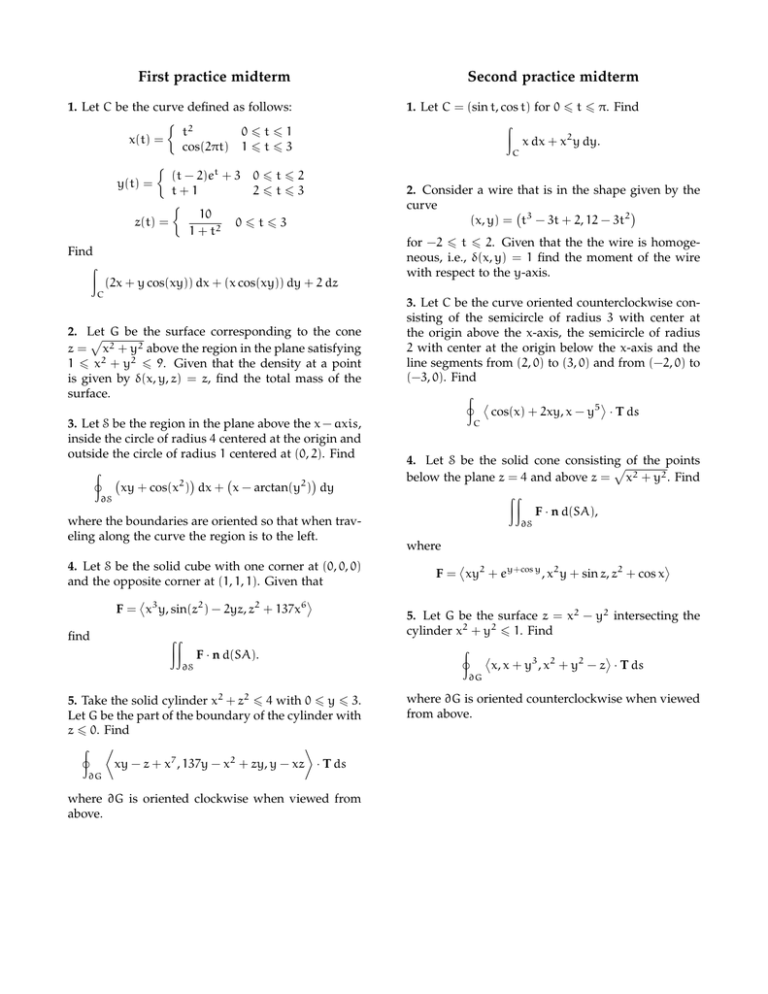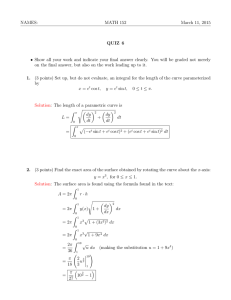First practice midterm Second practice midterm
advertisement

First practice midterm Second practice midterm 1. Let C be the curve defined as follows: � 2 t 0�t�1 x(t) = cos(2πt) 1 � t � 3 1. Let C = (sin t, cos t) for 0 � t � π. Find � x dx + x2 y dy. (t − 2)e + 3 0 � t � 2 t+1 2�t�3 � 10 z(t) = 0�t�3 1 + t2 y(t) = Find � � (2x + y cos(xy)) dx + (x cos(xy)) dy + 2 dz C 2. Let � G be the surface corresponding to the cone z = x2 + y2 above the region in the plane satisfying 1 � x2 + y2 � 9. Given that the density at a point is given by δ(x, y, z) = z, find the total mass of the surface. 3. Let S be the region in the plane above the x − axis, inside the circle of radius 4 centered at the origin and outside the circle of radius 1 centered at (0, 2). Find � � � � � xy + cos(x2 ) dx + x − arctan(y2 ) dy ∂S where the boundaries are oriented so that when traveling along the curve the region is to the left. 4. Let S be the solid cube with one corner at (0, 0, 0) and the opposite corner at (1, 1, 1). Given that � � F = x3 y, sin(z2 ) − 2yz, z2 + 137x6 find C t �� ∂S F · n d(SA). 5. Take the solid cylinder x2 + z2 � 4 with 0 � y � 3. Let G be the part of the boundary of the cylinder with z � 0. Find � � � 7 2 xy − z + x , 137y − x + zy, y − xz · T ds ∂G where ∂G is oriented clockwise when viewed from above. 2. Consider a wire that is in the shape given by the curve � � (x, y) = t3 − 3t + 2, 12 − 3t2 for −2 � t � 2. Given that the the wire is homogeneous, i.e., δ(x, y) = 1 find the moment of the wire with respect to the y-axis. 3. Let C be the curve oriented counterclockwise consisting of the semicircle of radius 3 with center at the origin above the x-axis, the semicircle of radius 2 with center at the origin below the x-axis and the line segments from (2, 0) to (3, 0) and from (−2, 0) to (−3, 0). Find � � � cos(x) + 2xy, x − y5 · T ds C 4. Let S be the solid cone consisting � of the points below the plane z = 4 and above z = x2 + y2 . Find �� F · n d(SA), ∂S where � � F = xy2 + ey+cos y , x2 y + sin z, z2 + cos x 5. Let G be the surface z = x2 − y2 intersecting the cylinder x2 + y2 � 1. Find � � � x, x + y3 , x2 + y2 − z · T ds ∂G where ∂G is oriented counterclockwise when viewed from above. Midterm from Spring 2012 - version 1 Midterm from Spring 2012 - version 2 1. As reigning champion of The Ultimate Extreme Roller Coaster Happy Fun Hour you have recently been hired to help design a new ride. Currently you are working on a portion of a ride where cart� moves √ 7/4the � 1 2 4 2 3/2 along the curve 5 + 2 t , 13 + 7 2t , 3 t where 0 � t � 1. You need to determine the amount of material needed to build the supporting structure for the ride, which will depend on the distance to the ground (the ground corresponds to the xy-plane), which is z for any particular point. Help� estimate the amount of material needed by finding C z ds. 1. As reigning champion of The Ultimate Extreme Roller Coaster Happy Fun Hour you have recently been hired to help design rides in amusement park. One of the rides that you are working on involves a large bowl-like surface on which people will be strewn into. In particular, the surface is z = 12 (x2 + y2 ) for 0 � z � 2. You are working to ensure the supports in place will be sufficient to support the weight. In particular the design calls for the density to be increase with the height, i.e., δ = z. Help �� estimate the total mass of the surface by finding δ d(SA). � � 2. Let C = (t137 − 1)et + cos(πt), 3t2 − π8 arctan t for 0 � t � 1. Find � � � � � 2y xy xy ye + cos x dx + xe + 2 dy. y +1 C 3. Let C1 be the curve which connects the following points (in the given order with straight line segments (1, 1) → (1, −1) → (−1, −1) → (−1, 1) → (1, 1), similarly let C2 be the curve which connects the following points (in the given order with straight line segments (3, 0) → (0, 3) → (−3, 0) → (0, −3) → (3, 0). Let C be the union of the two curves C1 and C2 . Find � � 2 � � � xy − y + cos(x2 ) dx + y7 + x2 y + x2 dy C (Hint: draw the picture; apply Green’s Theorem and calculate the integral using the picture.) 4. Let S be the solid hemisphere of radius 2 centered at the origin above the xy-plane. Find �� � � 2xy, ez −y2 +yz, cos(x+y)−sin(x−y) ·n d(SA). 2. Let C be the curve � � cos(πt2 ) + t137 , et(1−t) − sin(πt/2) for 0�� t � 1, and similarly let � F = 3y2 + cos(x + y), − cos(x + y) . Find � F · n ds. C dx (It might be useful to recall that n = � dy ds , − ds �.) 3. Let C be the curve consisting of straight line segments that visits the following points in the indicated order: (0, 0) → (2, 1) → (4, 0) → (5, 2) → (4, 4) → (2, 3) → (0, 4) → (−1, 2) → (0, 0). Find � � � � 2 3 y + cos(x ) − xy dx + 2xy + C 1 1 + e2y � dy. (Hint: draw the region; use Green’s Theorem then reinterpret the resulting integral as trying to find a parameter of the region with density δ = 1; compute this parameter in a different way.) ∂S (Hint: it might be useful to recall that z = ρ cos φ and r = ρ sin φ.) 5. Let G be the surface of an open box, namely we have vertices at (1, 1, 1), (1, 1, −1), (1, −1, 1), (1, −1, −1), (−1, 1, 1), (−1, 1, −1), (−1, −1, 1), and (−1, −1, −1) and five of the six sides of the box are present but the top side is missing (i.e., the side with vertices (1, 1, 1), (1, −1, 1), (−1, 1, 1), and (−1, −1, 1)). Compute the following � � 2 � 2 xy − 2y, xz + x2 y, ex − y137 + sin(z2 ) · T ds ∂G where the orientation on the boundary is counterclockwise when viewed from above. 4. Let S be the solid consisting of the set of points satisfying 1 � x2 + y2 � 4 and 0 � z � 3. Find �� � y � e −2xz, z4 −2y−sin(ex ), z2 +3z−ln(1+x2 ) ·n d(SA) ∂S 5. Let G be the surface of the hyperboloid of one sheet 1 + z2 = x2 + y2 with −1 � z � 2 and let the normal vectors n point out away from the z-axis. Find � � � yz, 3x + z2 − y13 , cos(x2 ) + sin(y2 ) · T ds. ∂G




